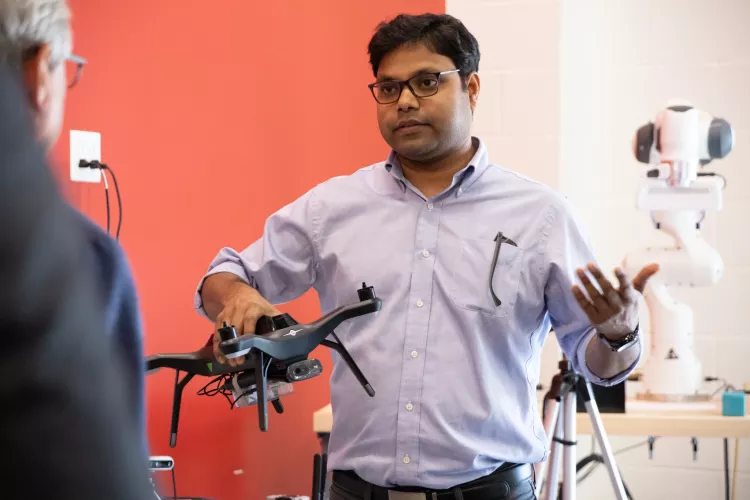Heading off catastrophe
AI safety expert races to control advanced AI systems before it’s too late. October 14, 2025
Artificial intelligence (AI) has become part of everyday life for most of us. From virtual assistants to text prediction to online directions, AI helps us with a multitude of daily tasks. While their safety, security and ethical use keeps AI safety experts busy, those systems operate in a limited sphere in which they can be tested, monitored and deactivated if necessary.
Much more robust systems are on the horizon, however. Technology companies are racing to develop superintelligent artificial general intelligence (AGI) systems that can learn, adapt and apply knowledge in a wide range of tasks at levels far exceeding human capabilities. The companies expect these systems will solve complex human problems and take over a vast array of activities. Experts predict a superintelligent AGI system may be developed within the next one to eight years.
Anyone who has seen “Terminator” or “The Matrix” might ask: “Will these systems operate safely and always work for human benefit?”
Those questions keep Associate Professor of Computer Science and AI safety expert Roman Yampolskiy up at night. He wants to be sure any superintelligent AGI system can be controlled before it is unleashed in society — not only protecting AI’s possible benefits, but preventing any unintended harm.
Making AI safer
Yampolskiy, who literally coined the term “AI safety,” has been working on the problem of controlling AGI for more than a decade. He was one of the first computer scientists to formally research AI safety and preventing harmful actions by AI systems — but he’s found it to be particularly challenging.
“We have many tools we would need to try to control the systems, so understanding what tools would be accessible to us is what we hope for. I am trying to understand — even in theory — how much of that tool is accessible,” Yampolskiy said. “With narrow systems, we usually rely on edge cases (tests that show how an AI system responds to unexpected requests). There are no edge cases with general intelligence. So, there are limits to even being able to test a system.”
To figure out what is possible, Yampolskiy is working to first determine what is impossible. In order to control an AGI system, you’d need to be able to explain a system’s decision-making process, predict how it would react in various situations and verify its accuracy. None of these capabilities are firmly established. Yampolskiy recently published a journal article describing 50 impossibility results - unsolvable problems to controlling AGI systems - and a book, “AI: Unexplainable, Unpredictable, Uncontrollable,” in which he explains in detail the problems with controlling such systems.
Yampolskiy has explored many potential solutions to AGI control issues, including monitoring the system’s processes from its creation and using multiple separate AI systems to control input and output of an AGI system. He believes it is critical to incorporate control and safety measures into any AGI system as it is being built and ensuring responsible development of all AGI systems.
“Historically, AI was a tool, like any other technology. Whether it was good or bad was up to the user of that tool. You can use a hammer to build a house or kill someone. The hammer is not in any way making decisions about it,” Yampolskiy said. “With advanced AI, we are switching the paradigm from tools to agents. The software becomes capable of making its own decisions, working independently, learning, self-improving, modifying.”
Once these systems reach a point of self- sufficiency, they are beyond human control. I don’t think it’s possible to indefinitely control superintelligence. By definition, it’s smarter than you. It learns faster, it acts faster, it will change faster. We have no precedent of lower capability agents indefinitely staying in charge of more capable agents.
— Roman Yampolskiy
Yampolskiy believes an uncontrolled superintelligent AGI system could very likely cause catastrophic outcomes for its human creators, whether of its own initiative, through a coding mistake or under direction of a bad human actor. The potential paths for these outcomes are too many to guess or imagine, but could include developing a pathogen that wipes out the human population or launching a nuclear war.
Brighter future
Make no mistake, Yampolskiy has plenty of enthusiasm for the benefits of AI, and he strongly advocates for its use in limited systems. Already, AI is being used to solve important problems in transportation, education, medicine and more, with the goal of helping people live better, healthier lives.
“We can use narrow AI tools to cure aging, an important problem and I think we are close on that front,” Yampolskiy said. “Free labor, physical and cognitive, will give us a lot of economic wealth to do better in many areas of society which we are struggling with today.”
Given the existential risk uncontrolled AGI poses for humanity, Yampolskiy is calling for developers to focus on increasing the benefits of narrow AI and to pause development of superintelligent AGI until controls are established and its safety can be assured, if that ever occurs.
“We should put some pressure on people who are irresponsibly moving too quickly on AI capabilities development to slow down, to stop, to look in the other direction,” Yampolskiy said. “This will allow us to only develop AI systems we will not regret creating.”
Betty Coffman is a communications coordinator focused on research and innovation at UofL. A UofL alumna and Louisville native, she served as a writer and editor for local and national publications and as an account services coordinator and copywriter for marketing and design firms prior to joining UofL’s Office of Communications and Marketing.
Related News




